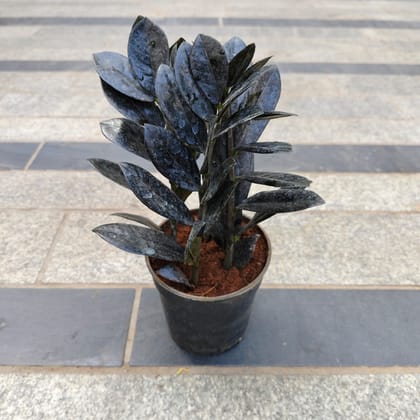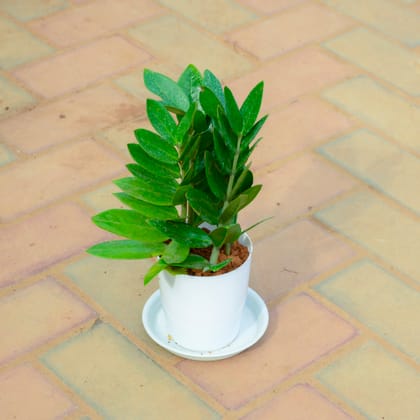- Plants
- Plants
- Home Decor Plants
- Home Decor Plants
- Pots
- Pots
- Soil & Add ons
- Soil & Add ons
- Seeds
- Seeds
- Tools
- Tools
- Decor
- Decor
- Gifting
- Gifting
- Bulk Gifting
- Bulk Gifting
- Gardening Kits
- Gardening Kits
- Outdoor Garden
- Outdoor Garden
- Others
- Others
- Sale
- Sale
- Best Selling Plants
- Best Selling Plants
Urvann is your one-stop online nursery for plants, planters, gardening accessories, and tools. Order fresh plants and get free home delivery on the next day!
ENUrvann is your one-stop online nursery for plants, planters, gardening accessories, and tools. Order fresh plants and get free home delivery on the next day!
https://www.urvann.com/s/6176774ef575bbd2b3331c8a/61db06dd744e78df7592f6d9/final-logo-01-1-_cropped-1.png https://www.urvann.com/s/6176774ef575bbd2b3331c8a/61db06dd744e78df7592f6d9/final-logo-01-1-_cropped-1.png +919599585773 [email protected]- Home
- ZZ Plant Collection
ZZ Plant Collection
Buy ZZ Plants Online in India at Urvann
ZZ plants, scientifically known as Zamioculcas zamiifolia, are popular indoor plants admired for their glossy, dark green leaves and ability to thrive in low-light conditions.
Also known as the Zanzibar Gem or the ZZ plant, this tropical plant is native to Eastern Africa. In recent years, it has gained popularity as a favourite choice among plant enthusiasts and beginners alike. Urvann has made Zz plant online shopping just a click away! Explore Zzplant online collection at Urvann.
Benefits of ZZ Plants:
Low-Light Tolerance: One of the significant advantages of ZZ plants is their ability to thrive in low-light environments. They can tolerate a range of light conditions, including fluorescent light and indirect sunlight. This makes them perfect for offices, apartments, or any indoor space with limited natural light.Low Maintenance: ZZ plants are known for their resilience and minimal care requirements. They have thick, fleshy leaves that store water, allowing them to survive extended periods without watering. They can also withstand infrequent watering and do not require frequent fertilization.
Air Purification: Like many indoor plants, ZZ plants have air-purifying qualities. They can help remove toxins and pollutants from the air, improving the overall indoor air quality and creating a healthier living environment.
Aesthetically Pleasing: The ZZ plant's lush, glossy leaves add a touch of elegance and sophistication to any indoor space. Its compact, upright growth habit makes it an excellent choice for tabletops, desks, or as a floor plant. It can complement a variety of interior design styles, from modern to traditional.
Care Tips for ZZ Plants:
Light and Temperature: While ZZ plants can tolerate low-light conditions, they do best in bright, indirect light. Avoid exposing them to direct sunlight, as it can scorch their leaves. They prefer temperatures between 65-75°F (18-24°C) but can tolerate slightly cooler or warmer conditions.Watering and Soil: ZZ plants have water-storing rhizomes that allow them to withstand periods of drought. Water the plant thoroughly, allowing the soil to dry out between waterings. Overwatering can lead to root rot, so it's better to be underwater than overwater. Use well-draining soil specifically formulated for indoor plants.
Pruning: ZZ plants are slow growers, but occasional pruning can help maintain their shape and remove any yellow or damaged leaves. Use clean, sharp pruning shears to make clean cuts and promote healthy growth.
Pest Control: ZZ plants are relatively resistant to pests but can occasionally encounter issues like mealybugs or spider mites. Regularly inspect the plant for any signs of pests and treat with organic pest control methods if necessary.
FAQ About ZZ Plants
1.Can ZZ plants be placed in low-light areas?
Yes, ZZ plants are known for their ability to thrive in low-light conditions. They can tolerate a variety of light levels, including fluorescent light and indirect sunlight. However, they may grow more slowly in lower light.
2. How often should I water my ZZ plant?
ZZ plants have water-storing rhizomes, allowing them to tolerate drought. It's best to allow the soil to dry out between waterings. Water the plant thoroughly, and then let the soil dry before watering again. Overwatering can lead to root rot, so it's important not to keep the soil too wet.
3. Are ZZ plants safe for pets?
ZZ plants contain calcium oxalate crystals, which can be toxic if ingested by pets. It's best to keep ZZ plants out of reach of curious pets to prevent any potential issues. If you suspect your pet has ingested any part of the plant and shows signs of illness, consult a veterinarian immediately.
4. Can ZZ plants be propagated?
Yes, ZZ plants can be propagated through division or leaf cuttings. Dividing the plant involves carefully separating the rhizomes and planting them in separate pots. Leaf cuttings can be taken from healthy leaves and placed in a well-draining potting mix until they develop roots.
5. Do ZZ plants require fertilization?
ZZ plants are relatively low-maintenance and do not require frequent fertilization. You can apply a balanced, diluted houseplant fertilizer once or twice a year during the growing season (spring and summer) to promote healthy growth. Be careful not to over-fertilize, as it can lead to salt buildup in the soil.
6. Can ZZ plants be placed outdoors?
While ZZ plants are primarily grown as indoor plants, they can be placed outdoors in mild climates. However, they should be protected from direct sunlight, as it can scorch their leaves. Additionally, avoid exposing them to temperatures below 45°F (7°C) as they are sensitive to cold.
7. Do ZZ plants produce flowers?
Yes, ZZ plants can produce small, cone-shaped flowers, usually hidden within the foliage. However, indoor ZZ plants rarely flower. They are primarily grown for their attractive, glossy leaves.
8. How can I maintain the glossy appearance of ZZ plant leaves?
To maintain the glossy look of ZZ plant leaves, gently wipe them with a damp cloth to remove dust and keep them clean. This will allow better light absorption and enhance their appearance.
Buy ZZ Plants Online in India at Urvann
ZZ plants, scientifically known as Zamioculcas zamiifolia, are popular indoor plants admired for their glossy, dark green leaves and ability to thrive in low-light conditions.
Also known as the Zanzibar Gem or the ZZ plant, this tropical plant is native to Eastern Africa. In recent years, it has gained popularity as a favourite choice among plant enthusiasts and beginners alike. Urvann has made Zz plant online shopping just a click away! Explore Zzplant online collection at Urvann.
Benefits of ZZ Plants:
Low-Light Tolerance: One of the significant advantages of ZZ plants is their ability to thrive in low-light environments. They can tolerate a range of light conditions, including fluorescent light and indirect sunlight. This makes them perfect for offices, apartments, or any indoor space with limited natural light.Low Maintenance: ZZ plants are known for their resilience and minimal care requirements. They have thick, fleshy leaves that store water, allowing them to survive extended periods without watering. They can also withstand infrequent watering and do not require frequent fertilization.
Air Purification: Like many indoor plants, ZZ plants have air-purifying qualities. They can help remove toxins and pollutants from the air, improving the overall indoor air quality and creating a healthier living environment.
Aesthetically Pleasing: The ZZ plant's lush, glossy leaves add a touch of elegance and sophistication to any indoor space. Its compact, upright growth habit makes it an excellent choice for tabletops, desks, or as a floor plant. It can complement a variety of interior design styles, from modern to traditional.
Care Tips for ZZ Plants:
Light and Temperature: While ZZ plants can tolerate low-light conditions, they do best in bright, indirect light. Avoid exposing them to direct sunlight, as it can scorch their leaves. They prefer temperatures between 65-75°F (18-24°C) but can tolerate slightly cooler or warmer conditions.Watering and Soil: ZZ plants have water-storing rhizomes that allow them to withstand periods of drought. Water the plant thoroughly, allowing the soil to dry out between waterings. Overwatering can lead to root rot, so it's better to be underwater than overwater. Use well-draining soil specifically formulated for indoor plants.
Pruning: ZZ plants are slow growers, but occasional pruning can help maintain their shape and remove any yellow or damaged leaves. Use clean, sharp pruning shears to make clean cuts and promote healthy growth.
Pest Control: ZZ plants are relatively resistant to pests but can occasionally encounter issues like mealybugs or spider mites. Regularly inspect the plant for any signs of pests and treat with organic pest control methods if necessary.
FAQ About ZZ Plants
1.Can ZZ plants be placed in low-light areas?
Yes, ZZ plants are known for their ability to thrive in low-light conditions. They can tolerate a variety of light levels, including fluorescent light and indirect sunlight. However, they may grow more slowly in lower light.
2. How often should I water my ZZ plant?
ZZ plants have water-storing rhizomes, allowing them to tolerate drought. It's best to allow the soil to dry out between waterings. Water the plant thoroughly, and then let the soil dry before watering again. Overwatering can lead to root rot, so it's important not to keep the soil too wet.
3. Are ZZ plants safe for pets?
ZZ plants contain calcium oxalate crystals, which can be toxic if ingested by pets. It's best to keep ZZ plants out of reach of curious pets to prevent any potential issues. If you suspect your pet has ingested any part of the plant and shows signs of illness, consult a veterinarian immediately.
4. Can ZZ plants be propagated?
Yes, ZZ plants can be propagated through division or leaf cuttings. Dividing the plant involves carefully separating the rhizomes and planting them in separate pots. Leaf cuttings can be taken from healthy leaves and placed in a well-draining potting mix until they develop roots.
5. Do ZZ plants require fertilization?
ZZ plants are relatively low-maintenance and do not require frequent fertilization. You can apply a balanced, diluted houseplant fertilizer once or twice a year during the growing season (spring and summer) to promote healthy growth. Be careful not to over-fertilize, as it can lead to salt buildup in the soil.
6. Can ZZ plants be placed outdoors?
While ZZ plants are primarily grown as indoor plants, they can be placed outdoors in mild climates. However, they should be protected from direct sunlight, as it can scorch their leaves. Additionally, avoid exposing them to temperatures below 45°F (7°C) as they are sensitive to cold.
7. Do ZZ plants produce flowers?
Yes, ZZ plants can produce small, cone-shaped flowers, usually hidden within the foliage. However, indoor ZZ plants rarely flower. They are primarily grown for their attractive, glossy leaves.
8. How can I maintain the glossy appearance of ZZ plant leaves?
To maintain the glossy look of ZZ plant leaves, gently wipe them with a damp cloth to remove dust and keep them clean. This will allow better light absorption and enhance their appearance.
Filter
- Sort ×
Urvann is your one-stop online nursery for plants, planters, gardening accessories, and tools. Order fresh plants and get free home delivery on the next day!
- Indoor Plants
- Low Maintenance Plants
- Flowering Plants
- Outdoor Foliage Plants
- Religious & Sacred Plants
- Air Purifying Plants
- Cactus & Succulents
- Good Luck Plants
- Plants by Location
- Plants of the Month
- Herbs-Medicinal & Vegetable Plants
- Fruit Plants
- Monsoon Plants
- Hanging Plants
- Potted Plants
- Bonsai Plants
- Special Plant Combos
- Bamboo Plant
- Pet Friendly Plants
- Plants to grow in Water
- Mosquito Repellent Plants
- Climbers & Creepers
Urvann India Private Limited
E-176
Delhi
Delhi 110060
IN
NEWSLETTER
Subscribe to get Email Updates!
Thanks for subscribe.
Your response has been recorded.












